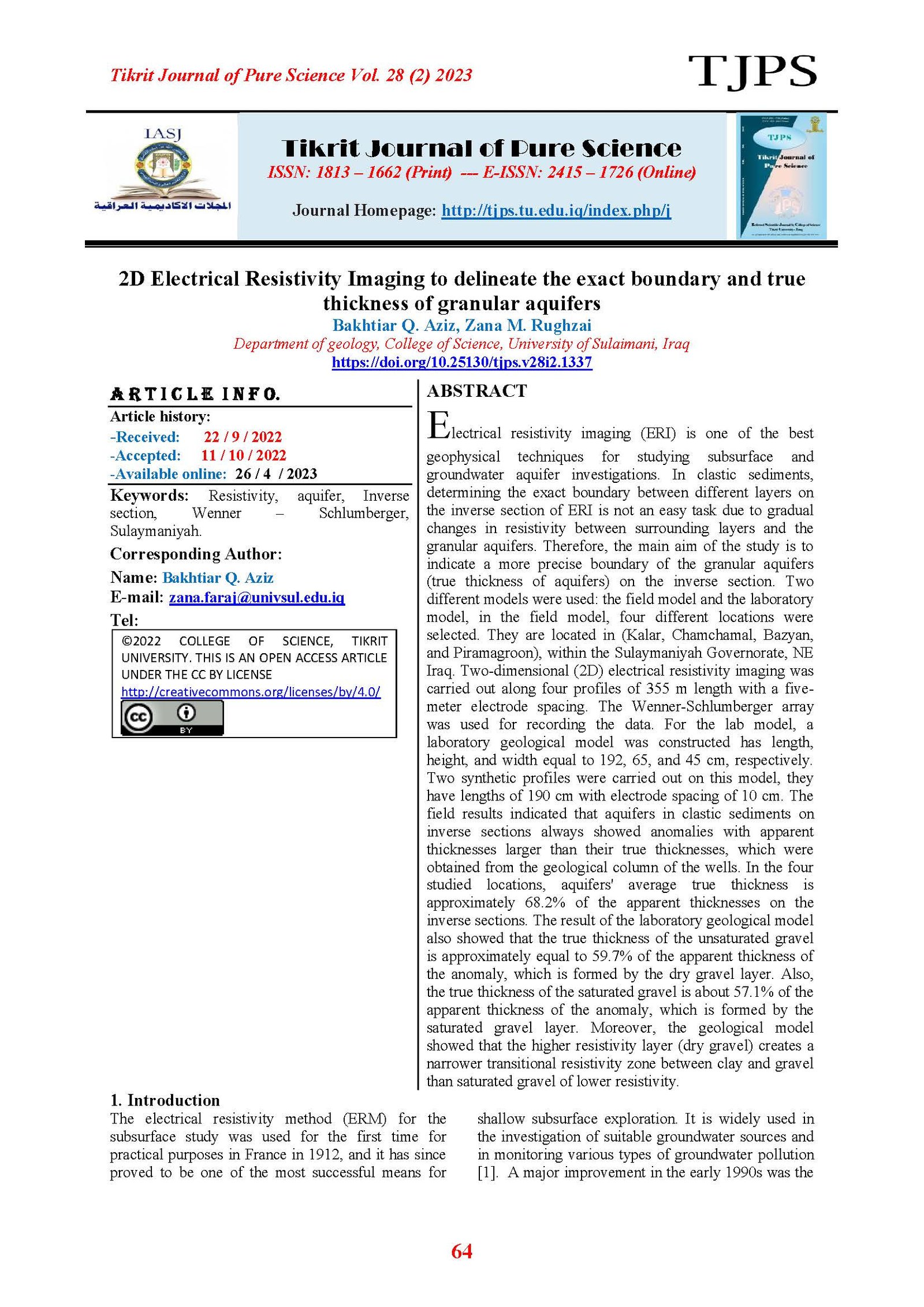2D Electrical Resistivity Imaging to delineate the exact boundary and true thickness of granular aquifers
Main Article Content
Abstract
Electrical resistivity imaging (ERI) is one of the best geophysical techniques for studying subsurface and groundwater aquifer investigations. In clastic sediments, determining the exact boundary between different layers on the inverse section of ERI is not an easy task due to gradual changes in resistivity between surrounding layers and the granular aquifers. Therefore, the main aim of the study is to indicate a more precise boundary of the granular aquifers (true thickness of aquifers) on the inverse section. Two different models were used: the field model and the laboratory model, in the field model, four different locations were selected. They are located in (Kalar, Chamchamal, Bazyan, and Piramagroon), within the Sulaymaniyah Governorate, NE Iraq. Two-dimensional (2D) electrical resistivity imaging was carried out along four profiles of 355 m length with a five-meter electrode spacing. The Wenner-Schlumberger array was used for recording the data. For the lab model, a laboratory geological model was constructed has length, height, and width equal to 192, 65, and 45 cm, respectively. Two synthetic profiles were carried out on this model, they have lengths of 190 cm with electrode spacing of 10 cm. The field results indicated that aquifers in clastic sediments on inverse sections always showed anomalies with apparent thicknesses larger than their true thicknesses, which were obtained from the geological column of the wells. In the four studied locations, aquifers' average true thickness is approximately 68.2% of the apparent thicknesses on the inverse sections. The result of the laboratory geological model also showed that the true thickness of the unsaturated gravel is approximately equal to 59.7% of the apparent thickness of the anomaly, which is formed by the dry gravel layer. Also, the true thickness of the saturated gravel is about 57.1% of the apparent thickness of the anomaly, which is formed by the saturated gravel layer. Moreover, the geological model showed that the higher resistivity layer (dry gravel) creates a narrower transitional resistivity zone between clay and gravel than saturated gravel of lower resistivity.
Article Details

This work is licensed under a Creative Commons Attribution 4.0 International License.
Tikrit Journal of Pure Science is licensed under the Creative Commons Attribution 4.0 International License, which allows users to copy, create extracts, abstracts, and new works from the article, alter and revise the article, and make commercial use of the article (including reuse and/or resale of the article by commercial entities), provided the user gives appropriate credit (with a link to the formal publication through the relevant DOI), provides a link to the license, indicates if changes were made, and the licensor is not represented as endorsing the use made of the work. The authors hold the copyright for their published work on the Tikrit J. Pure Sci. website, while Tikrit J. Pure Sci. is responsible for appreciate citation of their work, which is released under CC-BY-4.0, enabling the unrestricted use, distribution, and reproduction of an article in any medium, provided that the original work is properly cited.
References
[1] B. K. Aziz, “Groundwater Prospects in Parki-Azadi Area, Sulaimani City, NE-Iraq,” J Kurdistan Acad JA, vol. 1, pp. 15–25, 2001.
[2] D. H. Griffiths and R. D. Barker, “Two-dimensional resistivity imaging and modelling in areas of complex geology,” J. Appl. Geophys., vol. 29, no. 3–4, pp. 211–226, 1993.
[3] M. H. Loke and J. W. Lane, “Inversion of data from electrical imaging surveys in water-covered areas,” ASEG Ext. Abstr., vol. 2004, no. 1, pp. 1–4, 2004.
[4] B. Q. Aziz, “Two dimension resistivity imaging tomography for hydrogeological study in Bazian basin, west Sulaimani city, NE-Iraq,” Unpubl. Ph. D. thesis, Univ. Sulaimani, Sulaymaniyah, Iraq, 2005.
[5] B. K. Aziz and E. N. Baban, “Assessing reliability of 2D resistivity imaging to map a deep graben in Bazian basin, west Sulaimani City, NE-IRAQ.,” 2006.
[6] E. N. Baban and B. K. Aziz, “Two dimension resistivity imaging/tomography for hydrogeological study in Bazian basin-west Sulaimani City, Kurdistan region-Iraq,” in Near-Surface Asia Pacific Conference, Waikoloa, Hawaii, 7-10 July 2015, 2015, pp. 215–218.
[7] J. M. Thabit and M. M. AL-Hameedawie, “Delineation of groundwater aquifers using VES and 2D imaging techniques in north Badra area, Eastern Iraq,” Iraqi J. Sci., vol. 55, no. 1, pp. 174–183, 2014.
[8] J. M. Thabit and K. A. AL-Tamimi, “Delineation of Quaternary Aquifers by Using Long 2D Imaging in Southern Al-Shihaby Area (Wasit Governorate), Eastern Iraq,” Iraqi J. Sci., vol. 56, no. 1C, pp. 785–797, 2015.
[9] K. O. Aluko, W. O. Raji, and E. A. Ayolabi, “Application of 2-D resistivity survey to groundwater aquifer delineation in a sedimentary terrain: A case study of south-western Nigeria,” Water Util. J., vol. 17, no. 7, pp. 71–79, 2017.
[10] A. Madun, S. A. A. Tajudin, M. Z. Sahdan, M. F. M. Dan, and M. K. A. Talib, “Electrical resistivity and induced polarization techniques for groundwater
exploration,” Int. J. Integr. Eng., vol. 10, no. 8, 2018.
[11] A. A. AL-Juboury, J. M. Thabit, and F. H. AL-Menshed, “Determine the Groundwater Aquifers in Southwest of Samawah City,(Al MuthannÄ Governorate), Southern Iraq, by using 2-D Resistivity imaging survey,” Iraqi J. Sci., vol. 60, no. 4, pp. 792–802, 2019.
[12] Z. Asry, A. R. Samsudin, W. Z. Yaacob, and J. Yaakub, “Groundwater investigation using electrical resistivity imaging technique at Sg. Udang, Melaka, Malaysia,” 2012.
[13] I. Abubakar, N. S. Aliyu, A. L. Ahmed, and C. Collins, “Application Of Electrical Resistivity Method In Delineating Geological Boundary In Kakara Village, Kano State, Nigeria,” Int. J. Eng. Sci., vol. 2, no. 12, pp. 36–39, 2013.
[14] M. H. Loke, “Electrical imaging surveys for environmental and engineering studies,” A Pract. Guid. to, vol. 2, p. 70, 1999.
[15] A. M. Abed, K. K. Ali, and A. H. Al-Hadithy, “Resistivity surveys application for detection of shallow caves in a case example from Western Iraq,” Iran. J. Earth Sci., vol. 14, no. 3, pp. 178–185, 2022.
